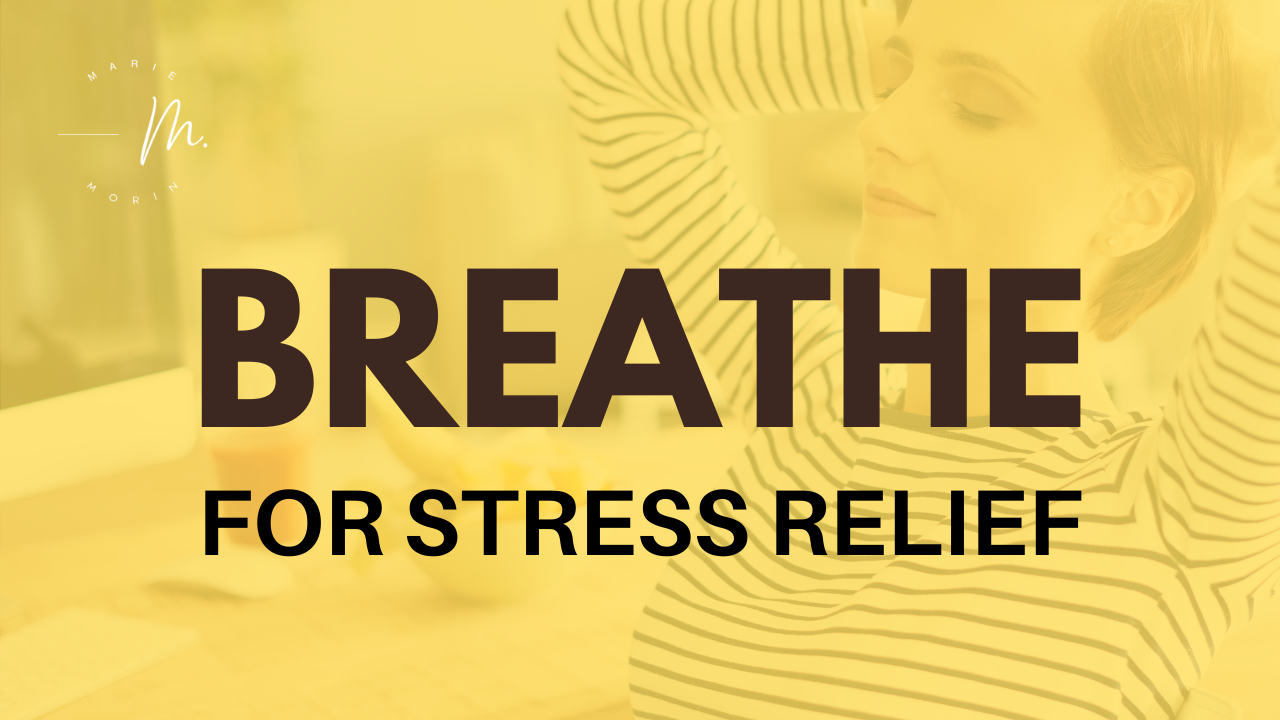Life is stressful, and if you’re juggling a career, home, and family, you may likely be experiencing overwhelm and high stress.
Could your standard of wanting things perfect making it difficult for you to stay in the moment and relax? It is something to think about at the very least.
We hear this sound advice everywhere. How do we put all these practices to work in our everyday busy lives? Decide which one you can start today, dive in, and don’t look back. Stress is not something we can run from forever. It will catch up to you.
How many times have you heard someone’s advice to stress taking a Deep Breath?
Taking a full deep breath is an excellent way to get more oxygen in your system and quiet the stressful response. Luckily, many breath patterns can bring about a state of calm. Learning to use the breath to enter into a relaxed state takes some practice.
Get to Know Your Body in a Relaxed State
When we are familiar with this relaxed state, we can more easily use the cue of feeling out of sync and a breathing exercise. In effect, you train yourself to know when you need to bring out the powerful breathwork practice. When you are alerted, you introduce yourself to respond and not react by recognizing the signs of stress.
In this article, you will learn ten simple and effective exercises to reduce stress, how the body shifts from stress to calm, and how to train yourself to benefit from breathwork optimally.
Perfect Breathing for Perfectionists
Perfectionists beware, there is no perfect breathing exercise; think of them as a banquet of excellent choices you get to pick. For those who would like to dig into this excellent stress-reducing quick, effective breathwork option, think variety. There are ten ways to keep you interested and motivated to try them all.
After checking them all out, consider mastering 2 or 3, so they become like muscle memory when you need to relax in a pinch.
Benefits of Breathing Exercises
In addition to having calming effects, breathing exercises lowers blood pressure, boosts immunity, improves feelings of wellbeing, improve sleep, helps relieve anxiety, helps relieve tension, increases oxygen in the blood, improves circulation, improves self-confidence, improves the ability to process emotions and improves the capacity of your lungs.
Is it any wonder that health educators have encouraged this practice?
Interestingly, most individuals breathe 10-12 breaths per minute when 6-8 is considered optimal. For the most part, breathing is shallow or thoracic breathing that limits the amount of necessary oxygen needed in the body. Shallow breathing is responsible for increased heart rate and is known to be a precursor to a panic attack. Studies of individuals who had frequent panic attacks measured Co2 in the blood and found that right before a panic attack came on, there was an increase in CO2. In effect, just before a panic attack, there is shallow breathing. If one is aware of shallow breathing, it may help them thwart a panic attack.
Breathing Exercises That Reduce Stress
Physiological Sighs
This breathing exercise mimics what the body does when one sob and sleeps. In terms of research and results, this one exercise is highly effective in producing a calm state. The sigh is a psychological and physiological reset that brings the central nervous system back into a state of balance when pushed into a fight or flight mode.
How to Practice the Physiological Sigh
- Allow yourself to be in a relaxed position with hands in your lap and feet planted on the floor.
- Close your eyes
- Exhale two quick short breaths from the nose
- Repeat three times
- If lightheaded, pause and resume for 2-3 more cycles.
Diaphragmatic Breathing
Diaphragmatic breathing is the most natural form of breath. Perhaps you have noticed newborn babies and how their bellies rise and fall. Stressful life circumstances start the slow descent into the habit of shallow breathing that serves little to relax the body.
The benefits of Diaphragmatic Breathing
The benefits of diaphragmatic breathing includes: strengthening the diaphragm, acclimating the body to use less effort to breathe, decrease the oxygen demand, and lowering your breathing rate. In this breathing exercise, you will slow your breathing rate, which will naturally help you feel more relaxed.
- When first practicing, try this lying down with your knees bent with a supportive pillow.
- As you progress, you can do this sitting if you choose.
- Place one hand on your lower abdomen and the other up by where a bra strap would be.
- Inhale slowly through the nose bringing the air deep into the abdomen so that your hand is raised by increasing air.
- On the exhale, gently contract your diaphragm, the muscle near the bra strap area.
- Inhale gently again, repeating and bringing the air deep into the abdomen and then gently exhaling.
- The idea is to allow your exhale to be accented as though your navel were meet your spine.
- Allow your inhale to be a natural response to the accented exhale.
- Keep an even slower pace of breathing, allowing yourself to feel the sensations of your belly falling and rising and the massaging of your diaphragm.
- Repeat this for about 5-10 cycles. Work up to 10 minutes 3 times a day for optimal benefits.
- Try diaphragmatic breathing in the morning before you look at your electronics.
Benefits of Bhramari Pranayama
In essence, Pranayama, where prana means “life energy” and “Yama” means “control,” is the art of respiration regulation. Yoga’s main component is Pranayama and can explain why we feel so much better after a modern yoga class. The combined breathing and poses have remarkable benefits. Numerous studies indicate that Pranayama is beneficial for trauma survivors.
Pranayama, at its core, provides a breathing pattern, a rhythm that benefits wellbeing by merging the physical and the mental. The ancients, who practiced controlled breathing, knew it reliably and positively impacts mood and relaxation. A 2010 study found that Bhramari pranayama’s practice lowered both blood pressure and heart rate.
Parasympathetic Dominance and Calm
Practicing breath techniques moves one into parasympathetic dominance, meaning the breath helps alternate one out of the stress, fight, or flight system or the sympathetic nervous system’s response into a calmer state of rest and digest. One such practice, Bhramari or Humming Bee, is beneficial to do at any time during the day, before going to sleep, or anytime one needs to wind down. For example, A 2010 study of Humming Bee Breath was studied with individuals and found that after 5 minutes of the exercise described below experienced lower blood pressure.
How to Practice Bhramari Pranayama
- Sit in a relaxed position with your spine straight.
- With your palms facing you, place your thumbs over your ear canals,
- Place your forefingers above your eyebrows, and your ring fingers on the outer side of your nose, with remaining fingers over your closed eyes.
- Inhale slowly for about 5 seconds and exhale slowly, making a humming sound through your nose for up to 15 seconds.
- Repeat this for five minutes.
- Stop and enjoy the sensation of increased oxygen and softened stress response.
- Take it in for a moment or more, feel the rest.
Alternate Nostril Breathing
Alternate nostril breathing is a yogic breath control practice. In Sanskrit, it’s known as Nadi shodhana pranayama. This translates as a “subtle energy clearing breathing technique.” This type of breathwork can be done as part of a yoga or meditation practice. It can also stand alone as an excellent combination of focus and relaxation.
Alternate of alternate nostril breathing benefits
Pranayama strengthens the connection between your body and mind. According to research, Pranayama can promote relaxation and mindfulness. It’s also proven to support multiple aspects of physical health, including lung function, blood pressure, and brain function.
How to do Nadi Shodana or Alternate Nostril Breathing
- Sit in an upright position with hands in your lap and feet planted on the floor.
- Place your right middle finger and ring finger just above the space between your eyes.
- Using your right thumb, press and close your right nostril.
- Breathe in with left nostril for a count of 5 holds for a count of 5.
- Using your left thumb, press and close your nostril.
- Breathe in with nostril for a count of 5 holds for a count of 5.
The 4- 7- 8 Breathing Exercise
There are many practices; the 4-7-8 one is easy to remember and highly effective. Everyone who has tried a breathing practice has most likely tried this easy to technique. It can be done anywhere and at any time. It is excellent to prepare for sleep or at any time you need a quick path to calm.
How to do a 4-7-8 Breathing Exercise
- Be prepared to relax so get comfortable where you can land and enjoy for a while.
- Begin by inhaling through the nose to the count of 4
- Holding for 7 seconds
- Release through the mouth for 8 seconds, making a whoosh sound.
- Repeat at first for four cycles, gradually increasing to 8 cycles.
- Notice how you feel before and after
- Memorize this relaxed feeling so when you are stressed again, you can remember to do this exercise and get back to relaxation with the 4-7-8 practice.
Two Times (2 X) Breath
In this breathing exercise, as in the others, you want to sustain a rhythmic pattern where your breath is quieter, slower, and more regular. The 2 X breath will help you focus as well as calm. This is an excellent morning routine breathing exercise to start your day.
Benefits of the Two Times Breath
As in the other exercises, the 2 X boosts immunity, lowers stress, increases oxygen, promotes relaxation and mindfulness. The two times breath exercise supports multiple aspects of physical health, including lung function, blood pressure, and brain function.
How to do Two Time Breath
- Get in a seated position with hands in your lap and feet planted on the floor
- Close your eyes and be sure to leave your distractions in another area
- Take a nice clean inhale through the nose for the count of 2
- and exhale through the mouth for a count of 4
- Repeat this pattern three times
- Then increase the inhale to the count of 3
- And exhale to the count of 6
- Do this pattern three times
- Then inhale to the count of 4
- Exhale to the count of 8
Box Breathing
Box breathing is best done by visualizing a square’s shape and moving from side to side with each change.
Special military forces use this technique to gain focus, calm, and deep relaxation. Also known as the four-square technique, boxed breathing is an effective relaxation exercise.
Benefits of Box Breathing
This exercise helps improve sleep, reduces anxiety, reduces stress, enhances the body’s ability to sustain stress, and improves mood.
- Get in a relaxed seated position with hands in your lap, feet planted on the floor, and eyes closed.
- Exhale from your nose to a count of four
- Hold for four
- Inhale to the count of four
- Hold the air in your lungs to the count of four
- Exhale for four
- Repeat the pattern a total of four times or for 4 minutes
- As you progress, you can make this pattern to the count of 5 or 6
- If four is uncomfortable for you, then make this pattern to 3 and work up to more.
Water Breathing Exercise
Do this exercise as often as you like. Think of this as your most helpful tool. It is very balancing and will help move out of the sympathetic nervous system into a state of rest and digest. You can do this anywhere at any time.
Benefits are to relax the body, increase oxygen, release stress and anxiety.
How to practice Water Breathing Exercise
- Preferably seated and relaxed without distractions if possible
- Inhale through the nose for 1 2 3 4 5
- Exhale for 5 4 3 2 1
- Repeat for about 5 minutes or ten cycles
Whiskey Breathing Exercise
Think of the whiskey breathing exercise as something you would do to relax before bed. You probably would not do this for when you need to be relaxed and focused since it is so relaxing.
The benefits of whisky breathing are how quickly it promotes deep relaxation and then sleep.
This exercise will help you to release stress, quiet a chatter-filled mind, release anxiety, improves and bring on a state of calm. If you need a quick bring down the pressure, immediately exercise; this is the one for you.
How to do the Whiskey Breathing Exercise
- If you are aiming to sleep, then lie down on your back with your spine straight,
- You can do this exercise sitting down with hands in your lap and feet planted on the floor.
- Close your eyes
- Inhale through the nose to the count of 4
- Hold for four
- Exhale for 4
- Hold for 4
- Repeat this for ten cycles or 10 minutes
- Enjoy the calm
The Coffee Breathing Exercise
- Get into a comfortable seated position.
- It will feel like you are sneezing, and you want to focus on the exhale through the nose.
- Exhale through the nose in short, focused bursts about 20 times
- Rest and repeat for three cycles being sure to rest in-between
- Repeat for 3 c cycles
Power of Breathing for PTSD
The overall benefits of breathing practices were outlined in multiple studies sighting research from a 2014 Stanford study of soldiers diagnosed with PTSD. Soldiers having completed tours in Iraq were taught breathwork. After three months of practicing, the study concluded that their symptoms were still absent after one year. If you know anything about the horrors of PTSD, this is pretty remarkable.
Body and Breath in Unison
Breathing is the only thing we can do both unconsciously and entirely consciously. The two sets of muscles include the involuntary and the voluntary nervous system, and therefore the only chance of influencing the automatic nervous system with an action. Instability in the autonomic nervous system is often responsible for chronic disease. The involuntary nervous system has two parts, the sympathetic, which is your fight or flight and prepares you for emergencies, and your parasympathetic, which is the opposite. When these parts are imbalanced, it creates dominance in the fight or flight response. When this occurs, there are chronic health problems.
Breathing techniques are effective not only to influence our body’s health positively but also to create the mind and emotions well. Practicing breathing exercises bridges the sympathetic nervous system’s connection and the parasympathetic nervous system. We want to yield to a state of rest and digest so we can come out of the high stare of stress as often as we can. Breathing is an excellent and easily available way to do this. This article described the benefits and steps to 10 simple and effective breathing exercises for stress relief.






